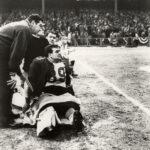Four Essential Warm-up Exercises to Prevent Rotator Cuff Tears
 As far as sports injuries go, one of the most common is the rotator cuff tear.
As far as sports injuries go, one of the most common is the rotator cuff tear.
Rotator cuff tears can affect any athlete, especially at the competitive or professional level. For example, both Jets wide receiver Eric Decker and former Los Angeles Lakers shooting guard Kobe Bryant have dealt with rotator cuff injuries during their careers.
Whether you’re a competitive athlete or just an average gym-goer, it’s important to take steps to protect your rotator cuff.
One of the best things you can do is to make sure you warm-up properly before every practice, game, or workout. Listed below are four essential exercises that will help you warm up and prevent rotator cuff tears.
Understanding the Rotator Cuff
Before getting into the specific exercises for the rotator cuff, it’s important to understand what the rotator cuff is and why it’s so susceptible to injury.
The rotator cuff is a group of four muscles that surround the shoulder joint. These muscles help stabilize the shoulder and prevent injuries.
Rotator cuff tears typically occur slowly over time and are the result of overuse. They’re especially common among weightlifters and other athletes who do a lot of repetitive overhand movements (throwing, reaching, swinging, etc.).
If you experience a rotator cuff tear, you likely won’t realize it right away. Over time, though, you may start experiencing the following symptoms:
-
Pain while at rest and while lowering or raising your arm
-
Weakness, especially when rotating or lifting your arm
-
A cracking sensation when you move your shoulder
Exercises to Prevent Rotator Cuff Tears
The following exercises are great to add to your warm-up routine. Whether you’re prepping for a practice or game or just a heavy lifting session in the gym, they’ll warm your rotator cuffs up and improve your mobility.
1. External and Internal Shoulder Rotation
Start by standing with your arms at your side. Bend your elbow and raise your right forearm so it forms a 90-degree angle. Then, rotate your hand away from your body, keeping your elbow close to your side.
You can do this exercise with a resistance band or a light dumbbell. Remember, the goal is to warm up the rotator cuff, not burn out the shoulder.
2. Cable Face Pulls
Adjust the cable station so it’s level with your chest. Attach a rope to the end, then grasp both ends of the rope — use an overhand, or pronated, grip.
Take a step back to create tension. Use a staggered stance with one foot forward and bend your knees slightly for stability.
Retract your scapulae (shoulder blades) and pull the rope up toward your face, bending the elbows while pulling the ends apart. When your hands get close to your face, externally rotate them so your knuckles face up toward the ceiling.
3. Dumbbell Scaption
Stand up straight and hold a pair of dumbbells with your palms facing inward. Raise the dumbbells up so they’re parallel with the floor, keeping your elbows straight and forming a wide V-shape with your arms.
Avoid lifting your arms up higher than your shoulders, and be sure to use a light weight when doing this exercise. As with the other rotator cuff exercises mentioned int he article, the goals is to warm up the rotator cuff, not stress the shoulder.
4. Active Doorway Stretch
Instead of doing a static doorway stretch to open the chest, make it active to engage the muscles and get the blood flowing properly.
Stand in a doorway with one palm resting flat on the wall. Place the other hand on your hip and stagger your feet as you did during the face pull exercise.
Lean into the doorway until you feel a stretch in your chest. Hold that position, then slowly release your palm from the doorway and pull it back a couple of inches. Hold that position for a second, then return to the beginning. Repeat on the other side.
Treating Rotator Cuff Tears
If you do end up experiencing a rotator cuff tear, you can still benefit from performing these four exercises. They’ll help you strengthen your rotator cuff and maintain mobility while you recover.
Some other steps you can take to treat your rotator cuff tear include:
-
Take a break from overhand exercises that aggravate your shoulder
-
Wear a shoulder brace designed to provide support for rotator cuff injuries
-
Alternate between hot and cold treatments to reduce pain and inflammation
-
Work with a physical therapist or personal trainer to correct muscle imbalances
Rotator cuff tears can be a pain to recover from, but with a proper strengthening routine and a treatment plan in place, you can prevent a lot of injuries and, if one does occur, minimize the amount of time you have to spend recovering.













